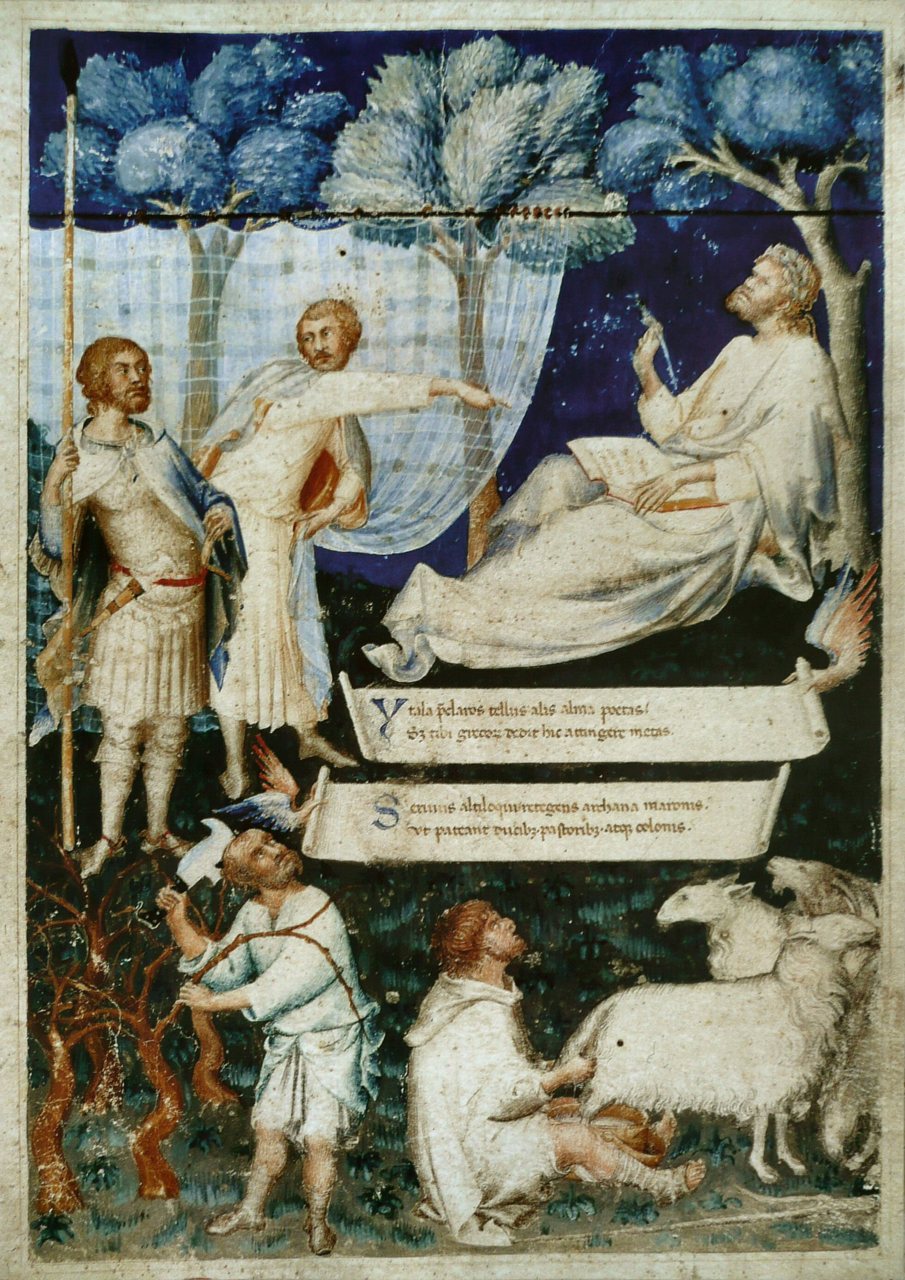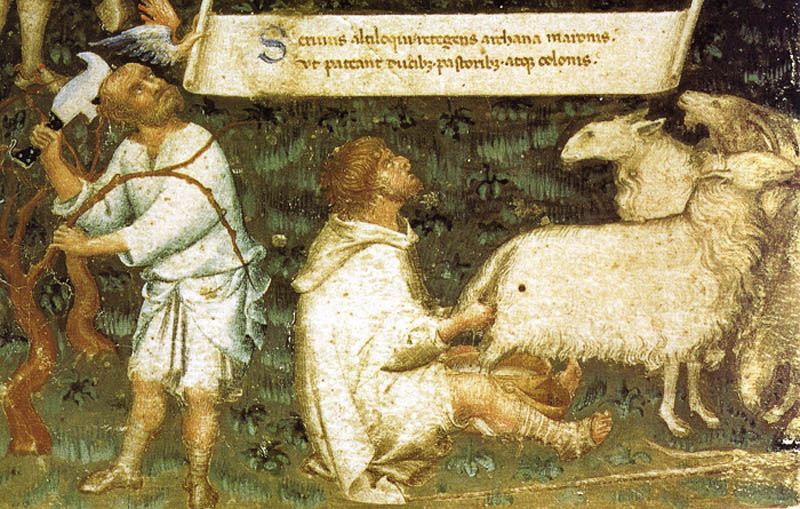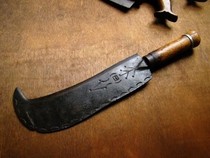
By Patrick Hunt
Francesco Petrarch’s (1304-74) father Ser Petracco – reputed to have known Dante – commissioned a copy of Virgil’s poetry (Publius Vergilius Maro) when the poet was young and this work formed a singular part of Petrarch’s peerless library. [1] This manuscript was so special to him that he had his visiting Sienese painter friend Simone Martini (1284-1344) paint the frontispiece with various scenes around 1336, while both lived in Avignon. [2] In friendship Petrarch also references Simone Martini in his Sonnet 77. This most famous painting, Petrarch’s Virgil frontispiece, includes the imagined figure of Virgil himself writing: alma poetas, one of Petrarch’s dear poets in Petrarch’s two couplets. The connected vignettes below the figure of laurel-wreathed Virgil in Martini’s frontispiece are mostly from the Georgics, including a shepherd shearing his sheep at lower right, likely alluding to Georgics 3.287-310 ff & 384-91. But it would not have been lost on the literary Petrarch how Virgil opens this passage:
“But meanwhile time is flying, flying beyond recall…enough this for the herds; there remains the second part of my task, to tend the fleecy flocks…Here is toil, hence hope for fame…and well I know how hard it is to win with words a triumph herein, and thus to crown with glory a lowly theme.“
That this bucolic task was connected to time and the passing seasons and to Virgil’s task of writing comes through loud and clear. That this image is on the frontispiece must have been important to Petrarch whose literary aspirations were also tied to his perceptions and love of Virgil.
Perhaps more important for this article, at the bottom left of this frontispiece is a winter scene of a rustic peasant pruning the grapevines. The bottom Latin couplet mentions, among other themes like the shepherd (in pastoribus), the fascinating phrase, archanes maronis, “secrets of Maro” that Petrarch felt privileged to understand.
Virgil’s lyricism on viticulture mentions (Georgics 2.333-4) the hardiness of the young vine: the “vine tendril does not fear the south wind’s rising or showers launched from the skies by the blustering north wind.” The poet also encourages good seasonal timing in Georgics 2.404-7 & ff:
“Already whenever the vineyard has shed her autumn foliage, and the north wind has shaken their glory from the trunks, the keen farmer extends his care to the coming year and pursues the vine he had left, lopping it with Saturn’s crooked knife and pruning it into shape.”[3]
Virgil’s Latin curvo saturni for Saturn’s knife is telling in that modern viticulture around the world still often uses a similar curved knife or billhook – like the sickle used by Saturn to castrate his father Uranus in Greek myth as Virgil alludes – in both harvesting grapes and pruning. While often serrated, it may go by various names in Europe, including serpe and serpette (French) and roncola (Italian).

Outside Avignon during the time when both of Petrarch and Martini lived there, vineyards were cultivated for the papal court, including the famous melange – often of six varietals – that became known as Chateauneuf du Pape. Both Petrarch, who climbed Mont Ventoux, and Martini would have been familiar with local vineyards, and Petrarch was hardly ascetic..
 This very roncola – curved pruning knife – mentioned by Virgil is seen wielded in the hand of the vinedresser at bottom left of Martini’s beautiful miniature as he looks up to his poet author. Legend has it that this manuscript was so precious to Petrarch that he had it in his hand on his deathbed. [4]
This very roncola – curved pruning knife – mentioned by Virgil is seen wielded in the hand of the vinedresser at bottom left of Martini’s beautiful miniature as he looks up to his poet author. Legend has it that this manuscript was so precious to Petrarch that he had it in his hand on his deathbed. [4]
Petrarch also wrote his own set of eclogues Bucolicum Carmen from 1346 onward after Virgil’s Georgics, although in his case the work was “pastoral as personal mythology.” [5]
Petrarch’s known familiarity with the biblical scriptures is also relevant. He often intersperses comments about Virgil and the Bible in his correspondence, for example this letter “On the Nature of Poetry” to his brother Gherardo:
“The fact is, poetry is very far from being opposed to theology. Does that surprise you? One may almost say that theology actually is poetry, poetry concerning God. To call Christ now a lion, now a lamb, now a worm, what pray is that if not poetical? And you will find thousands of such things in the Scriptures, so very many that I cannot attempt to enumerate them. What indeed are the parables of our Saviour, in the Gospels, but words whose sound is foreign to their sense, or allegories, to use the technical term? But allegory is the very warp and woof of all poetry.” [6]
Here Petrarch’s encomium on the figurative language of biblical poetry highlights the sacred use of allegory, letting one thing convey and allude to another through symbolic representation. It would also have been clear to Petrarch how much writing and the editing thereof have in common with vine-pruning, where the fruit of both is enhanced thereby.
In tandem with the general medieval perception of Virgil as proleptic of Christianity, [7] if Petrarch was also connecting the dots, however tenuous, from Virgil to Christianity, then another cherished idea from scripture could have presented itself to Petrarch, who cherished Classical scholarship as well as his faith: he might have also mused on the gospel text of John 15:1 – a familiar text to him [8] – where Christ said he was the Vine and his Father the Vinedresser, and every branch is pruned. Even disguised thus, such allusions in archanes maronis, the “secrets of Maro” might hold for Petrarch some significance of both his own mortality and his literary corpus in this viticultural image of Martini.
In conclusion, Petrarch wished his personal literary life to be parallel to Virgil’s, intending his own Bucolicum Carmen as an echo of the Georgics. He maintained what he believed as his vocational sacred task, that of a poet in some conjunction with Virgil. Identifying allegorically with the Georgics where lowly sheep tending is a sublime trope for the task of writing and living – no less than Christ was both the Good Shepherd and the Lamb of God – he also understood vine dressing as pruning and mortality; holding his Virgil manuscript so dearly on his deathbed in the then vineyard village of Arqua near Padua – less than 45 miles from Virgil’s Mantua – became a profound statement of this shared identity.
It is documented by the Ambrosian Library that Petrarch personally added inches own hand 2500 annotations to this total book, which included Virgil’s Bucolics and Aeneid, exegesis by Servius, works of Statius, Aelius and Horace, demonstrating Petrarch’s abiding love for the Classics and ultimately his own additions to bridging the Medieval to Renaissance worlds. [9]
[N.B. I appreciate assistance from Ellen Handler Spitz at Yale University for needed documentation, for which I am grateful.]
[1] Bibliotheca Ambrosian Milano. The Ambrosian Virgil of Francesco Petrarca, ca. 1300-26. This illustrated document came to the Ambrosian Library via Cardinal Federico Borromeo. (https://www.ambrosiana.it/en/opere/the-ambrosian-virgil-of-francesco-petrarca/). For some of Petrarch’s copious inserted annotations therein, see the copied “Nota de Laura”, Florence, 1468. General Manuscripts 109, Box 285, Folder 5127a (Spinelli Archive)
Bifolium, f. 1 recto. Yale University Library, Petrarch Gallery 10. Beinecke Rare Book and Manuscript Library. (http://brbl-archive.library.yale.edu/exhibitions/petrarch/10.html)
[2] Lisa Rabin. “Speaking to Silent Ladies: Images of Beauty and Politics in Poetic Portraits of Women from Petrarch to Sor Juana Inés de la Cruz.” Modern Language Notes 112.2 (1997) 147-165, esp. 151-2.
[3] H. Rushton Fairclough, tr. Virgil I. Eclogues, Georgics Aeneid 1-6. Cambridge, MA: Harvard University Press / Loeb Classics Library 63, 1999 rev. ed., 165.
[4] Bryson Burroughs. “A Loan of Italian Drawings and Miniatures.” Bulletin of the Metropolitan Museum of Art, n.d., 139
[5] Stefano Carrai, “Pastoral as Personal Mythology in History: Bucolicum Carmen” in Victoria Kirkham and Armando Maggi, eds. Petrarch: A Critical Guide to the Complete Works. University of Chicago, 2009, Ch. 9, 165-178.
[6] J. H. Robinson, ed. Francis Petrarch: Familiar Letters. New York: G.P. Putnam, 1898, 261-275, esp. 261-2.
[7] e.g., the Sortes Vergilianae, Virgilian bibliomancy in the medieval perception of Virgil as a prophet, also see Virgil’s Eclogue 4. Dante was not the only one who saw Virgil thus. Note Clyde Pharr, ed. Vergil’s Aeneid I-VI. Lexington, MA: D.C. Heath, 1964 ed., esp. the Introduction, p. 4: “…the reverence for his works reached the point where the Sortes Vergilianae came into vogue; that is, the Aeneid was opened at random and the first line on which the eyes fell was taken as an omen of good or evil…He [Virgil] was looked upon not only as a great magician but as an inspired pagan prophet who had foretold the birth of Christ. It was at this period that the spelling Virgil came into vogue, thus associating the great poet with the magic or prophetic wand, virga.”
[8] Petrarch’s De Vita Solitaria II (mainly ca. 1346) quotes from Augustine’s Tractates on the Gospel of John; also see Petrarch’s sonnet, Canzoniere 190, where Nessun mi tocchi alludes to Christ’s command to Mary Magdalene: Noli me tangere in Gospel of John 20:17.
[9] (https://www.ambrosiana.it/en/opere/the-ambrosian-virgil-of-francesco-petrarca/)